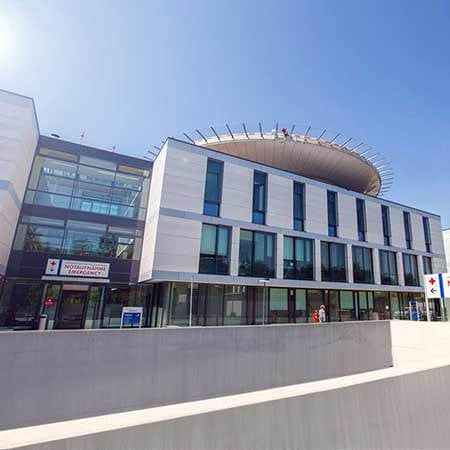Chronic myelogenous leukemia is a tumor of the hematopoietic system that develops from immature myeloid cells. These cells are the precursors of erythrocytes, platelets, and some types of leukocytes. The disease occurs mainly in adults. The pathology proceeds in three phases: a chronic phase, an acceleration phase, and a blast crisis. The first phase is smoldering and it lasts for 5 years or more. The last phase is the most dangerous, as it proceeds as an acute leukemia and causes the same complications, including sepsis and bleeding. You can undergo your diagnostics, treatment, and rehabilitation for chronic myelogenous leukemia in Germany. Modern drugs can control this disease for decades. To cure myelogenous leukemia in young people and children once and for all, doctors perform bone marrow transplantation.
Content
- Targeted therapy
- Immunotherapy
- Chemotherapy
- Radiation therapy
- Surgical treatment
- Allogeneic bone marrow transplantation
The main treatment method is targeted therapy with tyrosine kinase inhibitors. With an insufficient effect to this, doctors resort to chemotherapy and stem cell transplantation. Sometimes immunotherapy, radiation therapy, or spleen removal surgery can be performed.
You can undergo your treatment in one of the following hospitals: University Hospital Mannheim, University Hospital Ulm, or University Hospital Freiburg.
Please contact the specialists at the Booking Health company and we will help you to undergo your treatment for chronic lymphoblastic leukemia in Germany. The company's specialists will recommend a clinic and treatment method, make an appointment for your treatment without a long waiting period, book airline tickets and accommodation for you, translate your medical records into German, provide you with interpreting services, and advise you on any issues.
Targeted therapy
In chronic myeloid leukemia, the cells contain an abnormal BCR-ABL gene. It produces a protein that causes cancer cells to grow and multiply uncontrollably. To block BCR-ABL, doctors use tyrosine kinase inhibitors. These work best in the chronic phase of the disease, but can be used at any stage.
Targeted therapy does not cure chronic myelogenous leukemia completely, so the drugs are taken repetitively. With a good response to treatment, doctors sometimes reduce the dose or stop the medication for a while.
Immunotherapy
Immunotherapy for chronic myelogenous leukemia involves the use of interferon-alpha medication. This is an artificial protein that acts like the endogenous interferon produced by the human immune system. Interferon inhibits the growth and division of leukemic cells.
In the past, interferon was considered the main first-line treatment. However, this is rarely used now, due to the emergence of more effective drugs, such as tyrosine kinase inhibitors.
Interferon is injected every day. This may cause flu-like symptoms and also reduces the number of cells in the blood.
Chemotherapy
Previously, chemotherapy was considered to be one of the main treatments for myelogenous leukemia. As of today, it is rarely used, since targeted therapy with tyrosine kinase inhibitors is more effective.
Doctors use hydroxyurea to quickly lower the amount of white blood cells and shrink the enlarged spleen. Sometimes classical cytostatic chemotherapy can be conducted, which affects all the rapidly dividing cells in the body. For this reason, these drugs do cause a large number of side effects.
The chemotherapy drug omacetaxine can be used for chronic myelogenous leukemia. Chronic myelogenous leukemia is resistant to tyrosine kinase inhibitors and progresses to the acceleration phase quickly. The drug also works in patients with the T315I mutation. Most of these mutations do not respond to targeted therapy.
Radiation therapy
This treatment method is rarely used in German medical centers. Doctors resort to it if the patient requires a rapid reduction of the size of the organs that have become enlarged and caused the development of symptoms. For example, an enlarged spleen can put pressure on the stomach.
Radiation therapy is used to relieve pain in the bones if the tumor has spread to them. Low-dose radiation therapy can sometimes be used before a stem cell transplantation.
Surgical treatment
Myelogenous leukemia, like other types of hemoblastosis, can rarely be treated with surgery. Sometimes, a surgical intervention can be performed to remove an enlarged spleen. The operation can quickly relieve symptoms and also reduce the need for blood transfusions. However, the operation does not affect the clinical course or the outcome of leukemia in any way. A person can live without their spleen, but will be at an increased risk of developing bacterial infections. Therefore, the organ is not usually removed, but the cancer cells in this organ are destroyed with radiation therapy. In addition, even without any irradiation, the spleen shrinks over time under the influence of drug therapy.
Allogeneic bone marrow transplantation
A stem cell transplantation can rarely be used for myelogenous leukemia. This procedure used to be performed more frequently in the past, before the introduction of tyrosine kinase inhibitors.
An allogeneic bone marrow transplantation remains the only treatment that can cure both myelogenous and chronic lymphoblastic leukemia completely. Therefore, doctors recommend this treatment option for young patients and especially children. This is also offered to those who do not respond to standard therapy with tyrosine kinase inhibitors, or if the disease is diagnosed too late: if it is already in the acceleration phase or the blast crisis.
Prior to transplantation, doctors carry out high-dose chemotherapy to destroy all the cancer cells. It can sometimes be supplemented with irradiation. The high doses of drugs destroy the bone marrow. To restore hematopoiesis, doctors inject allogeneic stem cells intravenously – a patient's brother or sister is the best option, but an unrelated donor can also be found.
To undergo your treatment of chronic myelogenous leukemia in Germany or get medical care for myelogenous leukemia, you are welcome to use the Booking Health website. Here you can compare prices for treatment in different hospitals and book your treatment at the best price. We will help you to find the best clinics in Germany and arrange your trip.
Authors:
The article was edited by medical experts, board certified doctors Dr. Nadezhda Ivanisova and Dr. Sergey Pashchenko. For the treatment of the conditions referred to in the article, you must consult a doctor; the information in the article is not intended for self-medication!
Sources:
National Center for Biotechnology
Cancer Research Institute
European Society for Medical Oncology










